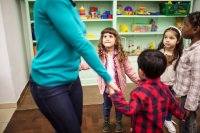Celebrating Fall Holidays Through Music and Dance
Comparing the differences and similarities of holidays through dance and music is a fun way for elementary students to celebrate the season.
Your content has been saved!
Go to My Saved Content.Many elementary schools are moving away from traditional holiday class parties and exploring ways to celebrate the seasons while embracing multiculturalism. Music- and dance-based activities offer an easy way to bring a celebratory feel to the classroom while developing cultural awareness.
Set intentions and ground rules to ensure that students explore artistic expressions from other cultures with a sense of curiosity and respect. Before you start, ask students to think about what it means to have an open mind, and conversely what it means to be close-minded. Prompt them to demonstrate or explain how they can show respect for something new and different in their body language, thoughts, and words.
Halloween and Día de los Muertos
As an alternative to a traditional Halloween party, students can explore the similarities and differences between the contemporary American version of Halloween and the traditional Mexican holiday of Día de los Muertos (Day of the Dead).
Halloween is celebrated on October 31 every year, while Día de Los Muertos is a three-day celebration that generally starts on Halloween and culminates two days later on November 2 (All Souls’ Day). Both celebrations involve costumes, treats, and graveyards, but there are also some big differences.
For example, Día de los Muertos celebrates the dead, while Halloween tends to focus on being afraid of the dead. Día de los Muertos uses many bright and festive colors in costumes and decorations, while Halloween veers toward dark and scary imagery.
Dance is not a big part of contemporary American Halloween celebrations, but there are a few iconic Halloween-themed dance tunes that can be fun for students. Students may enjoy watching and following along to the music of “Monster Mash,” a 1962 song by Bobby “Boris” Pickett. Choose from animated video versions of this song, such as this Just Dance 2 version.
Ask students to think about what it means to move like a monster. What qualities of movement make it scary or monster-like? Play the song again without showing a video, and encourage students to add their own version of monster movement to the song.
On Día de los Muertos, families honor their ancestors and loved ones who have passed away and invite those spirits back into their homes as a sign of honor and respect. Students can watch an example of a Día de Los Muertos traditional dance, such as the one found on the Smithsonian National Museum of the American Indian website.
After they watch dances from both traditions, ask students to talk about what they noticed. How did the dancers move? What stories might they have been telling through the movement? Comparing similarities and differences, students develop cultural awareness and learn to appreciate diversity. They will also develop critical thinking and observational skills as they consider the ways that movement is used to express ideas and tell stories.
Giving Thanks at Harvest Celebrations
In cultures throughout history and the world, harvest season is a time for celebration. At the heart of many of these traditions is the idea of giving thanks. Music and movement are a way of expressing gratitude for a fruitful harvest, and nearly every culture has some kind of harvest dance tradition.
To plan a harvest celebration for your class, explore how the harvest is celebrated with music and dance in several cultures. Consider looking for a harvest dance from a culture that is indigenous to your school’s area. Then, for contrast, consider any parts of the world where your students have ancestors. A few examples include the Zuni Harvest Dance; the Buhtuh laam from Mizoram, India; and the Lamba from West Africa.
On the day of your class celebration, invite students to consider how music and dance can be used to express gratitude and joy. Ask them to reflect on something they are grateful for and share this with a partner or write a brief reflection.
Next, show the videos of several harvest dances from around the world and encourage them to stand and respectfully follow along with the movement to the best of their ability.
Have them note similarities and differences between all of the videos you share. Note that what they consider different to them may not be to someone from another cultural background. Help your students see the threads of similarities while also celebrating differences.
After they respond to several harvest dance examples, have students revisit their own reflection on gratitude. Total Physical Response is a method for students to build vocabulary and explore meaning by expressing words and ideas through physical movement. Use the technique to challenge students to come up with a gesture or movement to represent what they are grateful for.
In small groups, students can share their movement ideas and connect each group member’s gesture into a short movement sequence. Complete the activity with a show and tell where each group can demonstrate their movement sequence and explain what it represents.
Through this activity, students will develop cultural awareness and consider the ways that groups of people express themselves through movement. They will also reflect on the timeless and universal idea of gratitude and experience how that can be expressed through movement.
Incorporating music and movement from multiple cultural origins creates a joyful and festive atmosphere in your classroom while allowing students to immerse themselves in global exploration.
